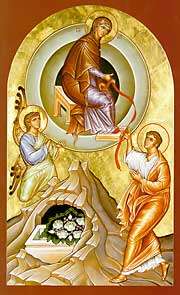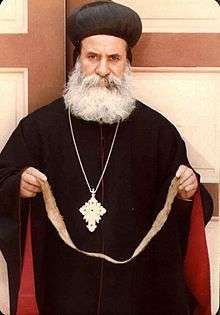Holy Girdle
 Holy Belt of Mary | |
| Material | Knotted Textile Cord |
|---|---|
| Size | Length (74cm) Breadth (5cm) Thickness (3cm) |
| Discovered |
1852, Rediscovered April 1953 Saint Mary Church of the Holy Belt, Homs, Syria |
| Discovered by | Patriarch His Holiness Ignatius Aphrem I Barsoum |
| Present location | Churches in Syria, India, Middle East |

The Holy Girdle, also known as the Girdle of Thomas, Holy Girdle of Mary, Holy Soonoro, (or) Zunoro, and Holy Belt of Saint Mary the mother of Jesus, is a relic of the Blessed Virgin Mary which is venerated by some members of the Orthodox Church. The word "soonoro" is also translated as "belt", "sash" or "girdle". It is the Orthodox equivalent of the Girdle of Thomas in the Western church, and the Cincture of the Theotokos, now at Mount Athos.
Tradition
According to Orthodox Church tradition, the Virgin Mary died in the presence of all apostles except Thomas the Apostle. At the time of the assumption, Thomas was in India and he returned to Jerusalem and travelled on the sky by the help of Holy Spirit to attend the assumption of Mary. But he was late in arriving and the saint visualised that Mary's body was taken by the Angels. At that time St.Thomas could reach there. Thomas had doubtful nature. In order to convince others he requested to Mary to give him any sign of her for her memory and remembrance. Then a chariot stopped in the air and Mary gifted her girdle to Thomas. Then he showed this girdle to other disciples of Jesus and convinced them. He took this soonoro(girdle) on his journey. A lot of miracles have happened since then by touching or even seeing this girdle. St.Thomas and the people believed its power. Gradually it was taken to Şanlıurfa, then it kept in a church in Homs in Syria. Supposing that he was seeing her soul and received blessing and Holy girdle from Virgin mary. This is the one of the Important incident, Which is not written in the bible. The original girdle is a relic belonging to Saint Mary Church of the Holy Belt and it is scientifically proved.[1][2]
History

Saint Thomas apostle kept holy belt with his, After he died as a martyr in Mylapore, the body of Thomas apostle and relics are kept in India. In 394 AD, The holy girdle moved from India to uraha. In the Syriac history of Şanlıurfa(The city has been known by many names in history: Ուռհա Uṙha in Armenian, ܐܘܪܗܝ Urhai in Syriac, ره, الرها, Ar-Ruhā in Arabic and Ορρα, Orrha in Greek (also Ορροα, Orrhoa).), it is mentioned that on August 22, 705. It was a Greek era.[3] and established in Saint Mary Church of the Holy Belt. This church is also known as holy girdle of church (or)The Church of the Lady of the Girdle .The supreme head Ignatius Aphrem I Barsoum Patriarch of Antioch studied about some manuscripts and Garshunian book containing stories and speeches send by the people of Homs in 1852. The archbishop of Homs ordered to renovate the church. On 20 July 1953 A.D, The Holy Girdle discovered from the Altar Of church by Patriarch Ignatius Aphrem I Barsoum and the presence of His Eminence Alexandros, the Greek Orthodox bishop of Homs, Syria. This Holy Girdle is considered as one of the most important relic in Syrian Orthodox Church.
Scientifically
Patriarch gave permission to destroy or break that altar in 1953 and found writings with the statement "This church was constructed in AD 59" and found St.Mary's soonoro in Silver plate. After that people of Homes and foreigners were attracted to this place. Some archiologist reached and examined its age and proved that it was true.The Holy girdle was tested by Radiocarbon dating by the archeologist and determine its age. After they confirmed its truth.[6]
Holy Girdle And Malankara Church
The Some parts of Holy Girdle is distributed into the Malankara Church and the churches which the relic is installed are Known as Soonoro Church with the name of the Church.[7][8][9][10][11][12][13]
Holy Soonoro Pilgrim Centers and Administration
- Manarcad Church - Jacobite Syrian Church,Universal Marian Pilgrim Center,Enshrined on 26 February 1982 by H.H Moran Mor Ignatius Zakka I Iwas.
- Kottayam Cheriapally - St Mary's Orthodox Church
- Jacobite Syrian Cathedral Kundara - Kollam Diocese of Jacobite Syrian Church,Enshrined on 1972 by American Arch Bishop Mor Athanasius Yeshu` Samuel.
- Kothamangalam Valiya pally Jacobite Syrian Church under Angamaly Jacobite Orthodox Diocese.Enshrined on 15-8-1980 by (Thomas Mor Dionasiyos) H.B Baselios Thomas I.[14]
- Mor Gregorios Jacobite Syrian Orthodox Cathedral Mettuguda (Secunderabad).Enshrined on November 11, 1983 by H.B Baselios Paulose II Catholicose.[15]
- St. Mary's Jacobite Syrian Church Vettithara under Kandanad Diocese, Jacobite Syrian Orthodox Church, Enshrined on 01-02-1987 by Baselios Paulose II
- St Mary's Jacobite Syrian Valiyapally, Thamarachal,Angamaly Diocese (Angamaly Region),Enshrined on 1988.
- St. Mary's Church Meenangadi - E.A.E Arch Diocese of Syrian Orthodox Church,Enshrined on 1991 by H.B Baselios Paulose II Catholicose.
- St.Mary's JSO Soonoro Church, Sulthan's Bathery, Malabar Diocese.
- St.Mary's JSO Soonoro Church, Velankode, Calicut Diocese.
- St.Mary's JSO Soonoro Church, Pattanikkoop,Pulpally,Malabar Diocese
- St Mary's Jacobite Syrian Church, Kannara Kallumedu Pally,Thrissur Diocese.
- St Mary's Knanaya Syrian Valiyapally, Kalliserry,Knanaya Archdiocese (Kalliserry Region).
- St Mary's Jacobite Syrian Church, Kallumedu,Idukki Diocese.
- St Mary's Jacobite Syrian Valiyapally, Thuruthiply,Angamaly Diocese (Perumbavoor Region).
See also
- Syriac Orthodox Church
- Jacobite Syrian Church
- Indian Orthodox Church
- Saint Mary Church of the Holy Belt
- St.Mary
References
- ↑ http://www.syriacchristianity.info/doc/HolyVirginMary.htm
- ↑ http://mgocsmdiaspora.org/blog/holy-soonoro-holy-gridle-of-our-mother-discovery/
- ↑ The Orien Biblio of Assimaany | Volume I | page 399
- ↑ Excerpts from a Patriarchal statement on the Girdle of Our Lady the Virgin Mary in the Church of Homs | Syria records how the belt was discovered. Thomas Joseph, Ph.D
- ↑ The Oxford History of Christian Worship | pg 157 | https://books.google.co.in/books?isbn=0195138864
- ↑ http://mgocsmdiaspora.org/blog/holy-soonoro-holy-gridle-of-our-mother-discovery/
- ↑ http://umalznar.com/church-3.htm
- ↑ http://umalznar.com/
- ↑ http://kundarajsc.com/about_soonoro.php
- ↑ http://www.thehindu.com/todays-paper/tp-features/tp-fridayreview/the-revered-relic/article5097889.ece
- ↑ http://www.stmaryspoothamkutty.org/soonoro
- ↑ http://sana.sy/en/?tag=saint-mary-church-of-the-holy-belt
- ↑ http://www.soc-wus.org/page.php?id=109
- ↑ http://valiyapally.com/photo_gallery.aspx
- ↑ http://www.thehindu.com/todays-paper/tp-features/tp-fridayreview/the-revered-relic/article5097889.ece
